(完整版)高考英语形容词与副词考点归纳
高考英语复习形容词和副词知识点讲解讲义(必考点)
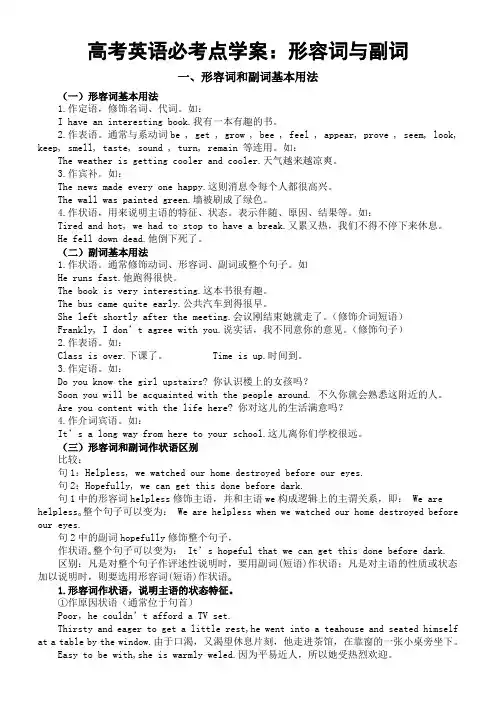
高考英语必考点学案:形容词与副词一、形容词和副词基本用法(一)形容词基本用法1.作定语,修饰名词、代词。
如:I have an interesting book.我有一本有趣的书。
2.作表语。
通常与系动词be , get , grow , bee , feel , appear, prove , seem, look, keep, smell, taste, sound , turn, remain 等连用。
如:The weather is getting cooler and cooler.天气越来越凉爽。
3.作宾补。
如:The news made every one happy.这则消息令每个人都很高兴。
The wall was painted green.墙被刷成了绿色。
4.作状语,用来说明主语的特征、状态。
表示伴随、原因、结果等。
如:Tired and hot, we had to stop to have a break.又累又热,我们不得不停下来休息。
He fell down dead.他倒下死了。
(二)副词基本用法1.作状语。
通常修饰动词、形容词、副词或整个句子。
如He runs fast.他跑得很快。
The book is very interesting.这本书很有趣。
The bus came quite early.公共汽车到得很早。
She left shortly after the meeting.会议刚结束她就走了。
(修饰介词短语)Frankly, I don’t agree with you.说实话,我不同意你的意见。
(修饰句子)2.作表语。
如:Class is over.下课了。
Time is up.时间到。
3.作定语。
如:Do you know the girl upstairs? 你认识楼上的女孩吗?Soon you will be acquainted with the people around. 不久你就会熟悉这附近的人。
高考英语语法必考:形容词和副词
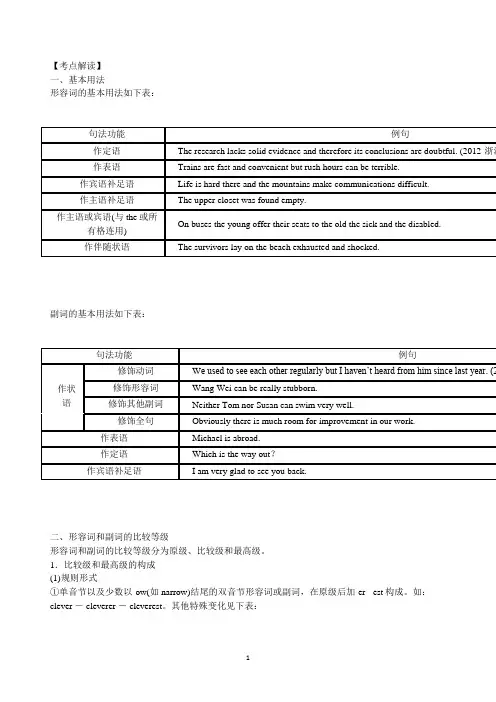
【考点解读】一、基本用法形容词的基本用法如下表:副词的基本用法如下表:二、形容词和副词的比较等级形容词和副词的比较等级分为原级、比较级和最高级。
1.比较级和最高级的构成(1)规则形式①单音节以及少数以-ow(如narrow)结尾的双音节形容词或副词,在原级后加-er -est构成。
如:clever - cleverer - cleverest。
其他特殊变化见下表:②多音节和部分双音节形容词和副词,在原级前加more most构成。
active - more active - most activehappily - more happily - most happily(2)不规则形式good/well - better - bestfar - farther/further - farthest/furthestbad /ill /badly - worse - worstold - older/elder -oldest/eldestmany/much - more - mostlittle - less - least2.基本用法(1)两者相比(甲=乙),用“as+原级+as”表示。
For cheerleaders their sport is just as serious as baxxxxseball or football.【温馨提示】在同等比较级中,若同时出现形容词修饰单数可数名词,其语序为:as+adj.+a+n.+as。
I have never had as boring a day as today.(2)两者相比(甲<乙),用“not as/so+原级+as”表示。
Unfortunately my wife isn’t so fond of them as I am.(3)两者相比(甲>乙),用“比较级+than”表示,(甲<乙)用“less+原级+than”表示。
高考英语语法知识总结形容词和副词
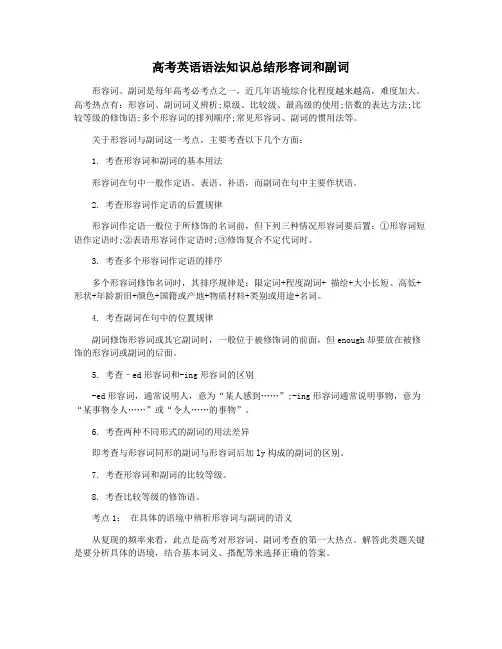
高考英语语法知识总结形容词和副词形容词、副词是每年高考必考点之一,近几年语境综合化程度越来越高,难度加大。
高考热点有:形容词、副词词义辨析;原级、比较级、最高级的使用;倍数的表达方法;比较等级的修饰语;多个形容词的排列顺序;常见形容词、副词的惯用法等。
关于形容词与副词这一考点,主要考查以下几个方面:1. 考查形容词和副词的基本用法形容词在句中一般作定语、表语、补语,而副词在句中主要作状语。
2. 考查形容词作定语的后置规律形容词作定语一般位于所修饰的名词前,但下列三种情况形容词要后置:①形容词短语作定语时;②表语形容词作定语时;③修饰复合不定代词时。
3. 考查多个形容词作定语的排序多个形容词修饰名词时,其排序规律是:限定词+程度副词+ 描绘+大小长短、高低+形状+年龄新旧+颜色+国籍或产地+物质材料+类别或用途+名词。
4. 考查副词在句中的位置规律副词修饰形容词或其它副词时,一般位于被修饰词的前面,但enough却要放在被修饰的形容词或副词的后面。
5. 考查–ed形容词和-ing形容词的区别-ed形容词,通常说明人,意为“某人感到……”;-ing形容词通常说明事物,意为“某事物令人……”或“令人……的事物”。
6. 考查两种不同形式的副词的用法差异即考查与形容词同形的副词与形容词后加ly构成的副词的区别。
7. 考查形容词和副词的比较等级。
8. 考查比较等级的修饰语。
考点1:在具体的语境中辨析形容词与副词的语义从复现的频率来看,此点是高考对形容词、副词考查的第一大热点。
解答此类题关键是要分析具体的语境,结合基本词义、搭配等来选择正确的答案。
经过统计,常见常考的形容词和副词有按频度排列:even; interested;interesting; yet; hardly; just; therefore; though; too; very; common;effective; either; ever; fair; however; less; more; nearly; only;purposefully; rather; still; such; surprised; surprising还有以下形容词和副词应当熟悉和掌握: a good many; a number of; acceptable; accidentally; actively; adequately; already; another; anxious; anyway; ashamed; attentively; bad; badly; besides; better; but; careful; changeable; cheap; comfortable; convenient; eagerly; easy; encouraging; enha-ncing; equal; even though; eventually; fairly; far; fewer;following; formally; friendly; gen-erously; gradually; heavily; historic; hopefully; immediately; inaccessible; individual; inevit-able; initial; instead; invisible; largely; never; next; no;normal; nowadays; obviously; ordin-ary; other; otherwise; patient;plenty of; prac-tical; promoting; proper; quickly; readily; reasonable; remote; seldom; seriously; short; so; stimulating; traditional; unavailable; unav-oidable; unfavorable; unfortunately; usual; va-rious; weak; well考点2:考查形容词、副词的比较级、最高级及前面的修饰语【备考清单】1 比较级、最高级的选用及应用范围比较级、最高级常用于表示两者或多者间的比较。
形容词和副词的知识点归纳英语
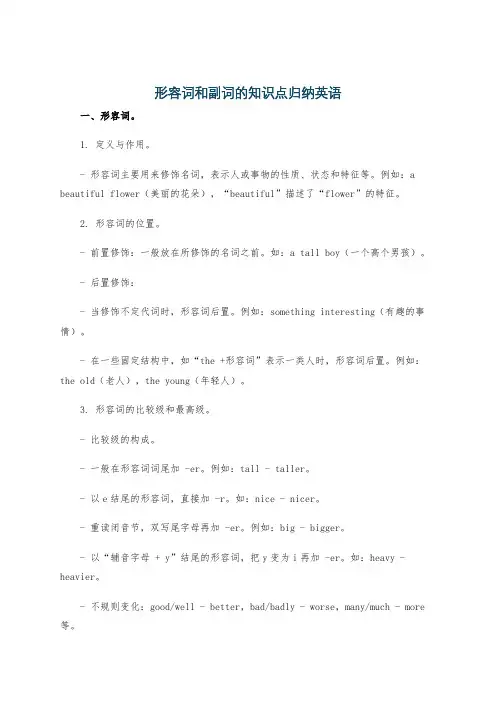
形容词和副词的知识点归纳英语一、形容词。
1. 定义与作用。
- 形容词主要用来修饰名词,表示人或事物的性质、状态和特征等。
例如:a beautiful flower(美丽的花朵),“beautiful”描述了“flower”的特征。
2. 形容词的位置。
- 前置修饰:一般放在所修饰的名词之前。
如:a tall boy(一个高个男孩)。
- 后置修饰:- 当修饰不定代词时,形容词后置。
例如:something interesting(有趣的事情)。
- 在一些固定结构中,如“the +形容词”表示一类人时,形容词后置。
例如:the old(老人),the young(年轻人)。
3. 形容词的比较级和最高级。
- 比较级的构成。
- 一般在形容词词尾加 -er。
例如:tall - taller。
- 以e结尾的形容词,直接加 -r。
如:nice - nicer。
- 重读闭音节,双写尾字母再加 -er。
例如:big - bigger。
- 以“辅音字母 + y”结尾的形容词,把y变为i再加 -er。
如:heavy - heavier。
- 不规则变化:good/well - better,bad/badly - worse,many/much - more 等。
- 最高级的构成。
- 一般在形容词词尾加 -est。
例如:tall - tallest。
- 以e结尾的形容词,直接加 -st。
如:nice - nicest。
- 重读闭音节,双写尾字母再加 -est。
例如:big - biggest。
- 以“辅音字母 + y”结尾的形容词,把y变为i再加 -est。
如:heavy - heaviest。
- 不规则变化:good/well - best,bad/badly - worst,many/much - most 等。
- 比较级和最高级的用法。
- 比较级用于两者之间的比较,常用结构有:A+be+形容词比较级+than + B。
高考英语语法之形容词和副词

高考英语语法之形容词和副词第一部分考点精讲精练第1讲比较级考点1.可以修饰比较级的词常用来修饰比较级的词或短语有:a bit, a little, rather, much, far, by far, many, a lot, a great deal, any, still, even等。
by far的用法:用于强调,意为“……得多” “最最……” “显然”等,可修饰形容词或副词的比较级和最高级,通常置于其后,但是若比较级或最高级前有冠词,则可置于其前或其后。
如:It’s quicke r by far to go by train. 乘火车要快得多。
She ran fastest by far. 她跑得最快(显然她跑得最快)。
He’s by far the cleverer student.他是个聪明得多的孩子。
He is by far the best teacher.=He is the best teacher by far.他是最最好的老师(或他显然是最好的老师)。
1.You are such a woman as always think ____ ofyourself than others.A. muchB. much moreC. littleD. much less2.【2004福建】The number of people present at theconcert was _____than expected. There were many ticket left.A. much smallerB. much moreC. much largerD. many more3.-The novel is, I have to say, not a bit interesting,How do you find it?-Why! It’s ____________ that I have ever read.A. a most interestingB. a more interestedC. a less interestingD. by far the most interesting4.【2007 全国II】After two years’ research, we no whave a ____ better understanding of the disease.A. veryB. farC. fairlyD. quite 5.------ The disease he suffers is not easy to cure.------ I know, but is he _____ better?A. muchB. ratherC. anyD. little6.【2000上海】You're standing too near the camera.Can you move ______ ?A. a bit farB. a little fartherC. a bit of fartherD. a little far7.【2006江苏】I wish you’d do ________ talking andsome more work. Thus things will become better.A. a bit lessB. any lessC. much moreD. a little more考点2.more 、much与比较级more 和多音节形容词和副词一起构成比较级,如more interesting, more exciting单音节词和部分双音节词在后面加-er构成比较级. 如:taller, earlier, hottermuch修饰比较级。
高中英语语法复习之形容词副词
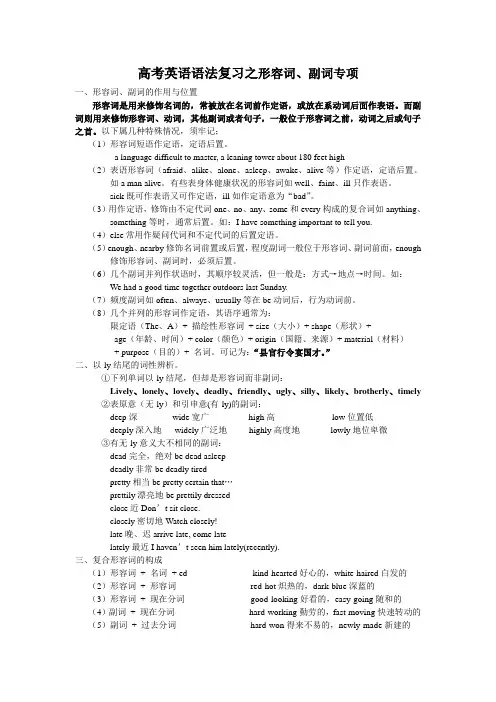
高考英语语法复习之形容词、副词专项一、形容词、副词的作用与位置形容词是用来修饰名词的,常被放在名词前作定语,或放在系动词后面作表语。
而副词则用来修饰形容词、动词,其他副词或者句子,一般位于形容词之前,动词之后或句子之首。
以下属几种特殊情况,须牢记;(1)形容词短语作定语,定语后置。
a language difficult to master, a leaning tower about 180 feet high(2)表语形容词(afraid、alike、alone、asleep、awake、alive等)作定语,定语后置。
如a man alive。
有些表身体健康状况的形容词如well、faint、ill只作表语。
sick既可作表语又可作定语,ill如作定语意为“bad”。
(3)用作定语,修饰由不定代词one、no、any、some和every构成的复合词如anything、something等时,通常后置。
如:I have something important to tell you.(4)else常用作疑问代词和不定代词的后置定语。
(5)enough、nearby修饰名词前置或后置,程度副词一般位于形容词、副词前面,enough 修饰形容词、副词时,必须后置。
(6)几个副词并列作状语时,其顺序较灵活,但一般是:方式→地点→时间。
如:We had a good time together outdoors last Sunday.(7)频度副词如often、always、usually等在be动词后,行为动词前。
(8)几个并列的形容词作定语,其语序通常为:限定语(The、A)+ 描绘性形容词+ size(大小)+ shape(形状)+age(年龄、时间)+ color(颜色)+ origin(国籍、来源)+ material(材料)+ purpose(目的)+ 名词。
可记为:“县官行令宴国才。
高考英语形容词与副词考点归纳
高考英语形容词与副词考点归纳一、形容词和副词的基本用法A.形容词:就是用来修饰名词或不定代词,表示人或事物的性质、状态和特征的词。
形容词主要作定语、表语、补语。
如:1. This is a new pen. 这是支新钢笔。
(形容词new作名词pen定语)2. These oranges taste ________. (全国卷)A. goodB. wellC. to be goodD. to be well【分析】答案选A。
系动词taste(尝起来)后要接形容词作表语。
3. John was so sleepy that he could hardly keep his eyes ________. (全国卷)A. openB. to be openedC. to openD. opening【分析】答案选A。
形容词open(开着的)作宾补,表示状态。
注意:不要选答案D,因为open是短暂性动词,不能表状态。
B.副词:就是修饰动词、形容词、其它副词或全句,说明时间、地点、程度、方式等概念的词。
副词在句中主要作状语。
如:It's raining heavily. 雨下得很大。
(副词heavily修饰谓语动词)It's a rather interesting job. 这是一份相当有趣的工作。
(副词rather修饰形容词interesting)She speaks English very well. 她的英语说得很好。
(副词very修饰副词well) This is just what he said. 这正是他所说的。
(副词just修饰what he said)注:here, there, in, out, away, abroad等少数副词也可以作表语;here, there, home, abroad, below等表示地点或方位的词及today, tomorrow, yesterday, back, out等表示时间或动词方向词还可以作定语。
高考英语形容词和副词考点总结。
高考英语:形容词和副词【考查要点】1) 原级,比较级、最高级的选用及应用范围,复习中须注意如下句型的用法:①as + 原级adj. / adv. + as表“和…一样”;not as / so + 原级adj. / adv. + as表“不如…”。
例如:John plays football as well as David. Tom does not play the piano so/as well as Jack.The violin in the other shop will be cheaper, but not as good.②as + 原级adj. + a(n) + n. + as表“跟…一样”。
如It’s believed that teaching is as much an art as it is a science. Our neighbor has as big a house as ours.③比较级+ than表“比…更”;less+原级+ than表“不如…”。
如:This year they have produced less grain than they did last year. This road is wider than that one.④the + 比较级,the + 比较级表示“越…,就会越…”。
例如:It’s believed that the harder you work, the better result you’ll get.⑤the +比较级+ of the + two/名词/代词表两者中“较…的一个”。
如:Who is the younger of the two boys?⑥比较级+and+ 比较级表示:越来越…。
如:Our country is getting stronger and stronger.⑦用the last表示“最不可能的”、“最不适合的”、“最不希望的”等。
高考英语形容词和副词讲解
2.-ed形容词通常用于说明人的感受,常译为“感到……的”,强 调人自身的情感波动;修饰事物时,则多修饰air(神态),smile (微笑),feeling (感觉),appearance (容貌),cry (哭声),face (表情),voice (声音),mood (情绪),look (表情),eye (眼神)等 显示某人情感状况的名词。
在下列情况下,形容词要放在被修饰词的后面。 (1)形容词作定语修饰somebody,something,anyone,anything, nobody等复合代词时,需后置。 Is there anything wrong with your car? 你的汽车出什么毛病了吗?
(2)以-able或-ible结尾的形容词可置于由形容词的最高级或all, every,only等词修饰的名词后面。 This is the best computer available. 这是现在可用的最好的一台电脑。 (3)形容词短语作定语要后置。 That is a problem difficult to answer. 那是一个难以回答的问题。 (4)表语形容词(alive,asleep,awake,alike,available等)作定语, 一般要后置。 The girl awake is his younger sister. 那个醒着的女孩是他的妹妹。
填一填
3.present 目前的,现在的;出场的,出席的
目前的形势
在场的雇员
答案 the present situation;the employees present
4.concerned 担心的,焦虑的;有关的,有牵连的
忧心忡忡的医生
(与……事情)有关的医生
答案 the concerned doctor;the doctor concerned
高三英语高考语法知识点归纳总结形容词和副词
用比较级来表达最高级的意思
我从来没有度过这样令人烦恼的一天。 (意为:我度过了最为令人烦恼的一天。 )
表达法一: A is three(four, etc.)times the size(height,
length etc.)of B. The new building is four times the size(the height)of the old one. 这座新楼是那座旧楼的四倍大(高) / 这座新楼比那 座旧楼大(高)三倍。 表达法二: A is three(four, etc.)times as big(high, long,
perfect, superior,junior 等
twice 或 double. 注意: 1. 可以修饰比较级的词有: much, many, a lot, even, far, a bit, a little, still, yet, by far, any,
a great deal;
2. 表示“最高程度“的形容词没有最高级和比较级。如:
favourite, excellent, extreme,
only 修饰的名词之后
the best book available, the only solution possible
alive, alike, awake, aware, asleep 等作定语时后 3
置
the only person awake
4 和空间、时间、单位连用时 5 成对的形容词可以后置
a bridge 50 meters long a huge room simple and beautiful
6 形容词短语一般后置
a man difficult to get on with
- 1、下载文档前请自行甄别文档内容的完整性,平台不提供额外的编辑、内容补充、找答案等附加服务。
- 2、"仅部分预览"的文档,不可在线预览部分如存在完整性等问题,可反馈申请退款(可完整预览的文档不适用该条件!)。
- 3、如文档侵犯您的权益,请联系客服反馈,我们会尽快为您处理(人工客服工作时间:9:00-18:30)。
B. large
white German C. white large German
• D. German large white
ห้องสมุดไป่ตู้
• 2. ________ students are required to take part in the boat race. (浙江卷)
• A. Ten strong young Chinese B. Ten Chinese strong young C. Chinese ten young strong D. Young strong ten Chinese
• here, there, home, abroad, below等表 示地点或方位的词及today, tomorrow, yesterday, back, out等表示时间或动词 方向词还可以作定语。如:
• Tom isn’t here. (here作表语)
• The people there were very kind to us. (副词there作定语,修饰people)
• A. so well
B. so good
• C. well enough D. good enough
• 2. If I had ________, I’d visit Europe, stopping at the small interesting places.
• A. a long enough holiday B. an enough long holiday C. a holiday enough long D. a long holiday enough
• A.形容词短语作定语时要后置。
• ________ to take this adventure course will certainly learn a lot of useful skills.
• A. Brave enough students B. Enough brave students C. Students brave enough D. Students enough brave
• medical, daily, weekly, electric, former(前 任的), some, any, little, many, 及oneeyed之类的复合形容词等。
• This is a medical school
• 三、形容词作定语的后置规律
• 形容词作定语一般位于所修饰的名词 前,但是在下列情况要位于所修饰的 名词之后:
• B.表语形容词作定语要后置。如:
• All the people ________ at the party were his supporters.
• A. present
B. thankful
• C. interested D. important
• C.形容词修饰不定代词something, anything, nothing等时
高考英语形容词与副词考点归纳
一、形容词和副词的基本用法
形容词: 用来修饰名词或不定代词,表 示人或事物的性质、状态和特征的词。 主要作定语、表语、补语。如:
John was so sleepy that he could hardly
keep his eyes ________.
A. open
B. to be opened
• 3. The ________ house smells as if it hasn’t been lived in for years. (江苏卷)
• A. little white wooden • B. little wooden white • C. white wooden little • D. wooden white little
• 二、定语形容词与表语形容词
• 有的形容词一般只作表语,如表示健 康状况的well, unwell, ill, faint
• 表示情感反应的glad, sorry, fond, worth, able
• 以a开头的afraid, alone, asleep, alive, awake, alike, ashamed等。
• -ed形容词,意为“感到…”;
• -ing形容词,意为“(某事物)令人…” interested / interesting; excited / exciting; frightened / frightening; surprised / surprising; pleased / pleasing; moved / moving; disappointed / disappointing等。
C. to open
D. opening
• 副词:修饰动词、形容词、其它副词或 全句,说明时间、地点、程度、方式等 概念的词。副词在句中主要作状语。
• It’s raining heavily. 雨下得很大。
• It’s a rather interesting job. (副词rather 修饰形容词interesting)
• D. Enough strange
• 2) 频度副词always, usually, often, never 等一般放在行为动词前,或者情态动 词、助动词或be动词之后。如:
• She always gets up early. (副词always放 在行为动词gets之前)
• She is seldom late for school. (副词 seldom放在be动词之后)
• 3. ________, some famous scientists have the qualities of being both careful and careless. (上海卷)
• A. Strangely enough B. Enough
strangely
C. Strange enough
• 但有的可作后置定语或补语。
• 通常只作定语的形容词:only(唯一的), single(唯一的), certain(某一), real(真正 的), true(真正的), very(正是), live(活的), exact(准确的), present(在场的)
• 由名词等转化的wooden(木制的), woolen(羊毛制的), drunken(醉的),
• 3) 表示地点的副词常放在句末;表示 确定时间的副词放在句首或句末;表 示方式的副词词通常放在“动词(+宾语)” 之后,也可放在其它位置;同时有表 示时间、地点和方式的副词时,其顺 序一般为:方式+地点+时间。如:
• ________ I went to the railway station to see my friend off. (全国卷)
美小圆旧黄,法国木书房。
• 五、副词在句中的位置规律
• 1) 副词修饰形容词或其它副词时,一 般位于被修饰词的前面,但enough却
要放在被修饰的形容词或副词的后面。 如:
• 1. —Mum, I think I’m ________ to get back to school.
• —Not really, my dear. You’d better stay at home for another day or two.
• Is there anything important in the paper? 报纸上有什么重要新闻吗?
• 四、多个形容词作定语的排序
• 1. John Smith, a successful businessman, has a ________ car. (辽宁卷)
• A. large German white
• She speaks English very well. (副词very修 饰副词well)
• This is just what he said. (副词just修饰 what he said)
• here, there, in, out, away, abroad等少数 副词也可以作表语;
• —Mn, it does have a ________ smell.
• A. pleasant; pleased B. pleased; please
• C. pleasant; pleasant D. pleased; pleasant
• He told me the news in an excited voice.
• The man is interesting. • 另外,glad, happy, sorry, angry, thankful,
proud等的主语也只能是人;而pleasant, easy, difficult, important等则通常以事物或 it作主语,因为它们是说明事物的。 • —I’m very ________ with my own cooking. It looks nice and smells delicious.
• A. After eating quickly my dinner B. After my quickly eating dinner
• C. After eating my dinner quickly D. After eating my quickly dinner
• 六、–ed形容词和-ing形容词的区别
